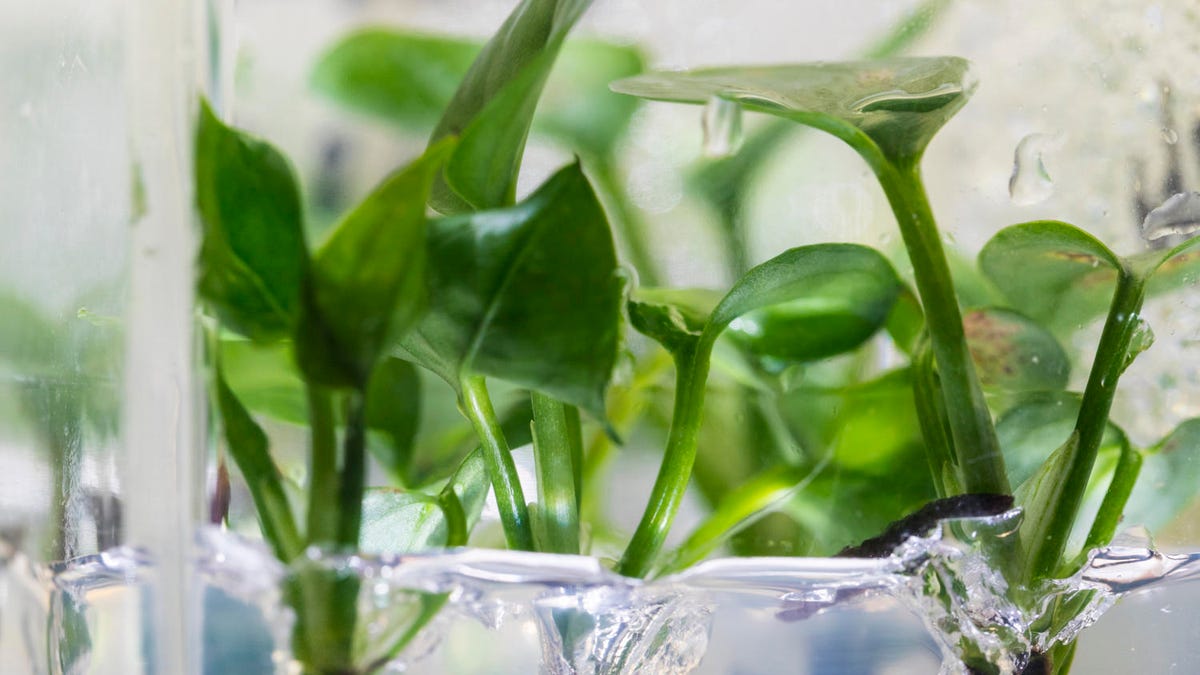Houseplants aren’t just for looking at, although they’re lovely to have around to enhance aesthetics. Some plants keep bugs away, while others are known to cool your home’s air during hot summer months, a helpful benefit that might save you from firing up the AC on milder days. For crisp, clean air that’ll keep you happy, healthy and cool, we rounded up the best houseplants for air purification. We also created a list of plants that thrive in low-light environments — so you don’t have to worry about them withering away.
Choosing low-maintenance plants or those that don’t require hours of direct sunlight can help you become a more successful plant parent. Certain indoor plant species are objectively harder to kill and others are better at purifying air. Translation: Some houseplants are way hardier and are better for beginner green thumbs, especially if you don’t have a lot of time and energy to devote to indoor greenery.
Whether you’re working with limited natural light, a busy schedule or musty air that needs purifying, there are plants out there to give your space a needed boost. (Make sure you also check out which spots to place your plants to keep them alive and the 10 freeze-proof plants that will survive a winter outside.)
Best houseplants for air purification
Researchers at the University of Washington have genetically modified a common houseplant — pothos ivy — to remove chloroform and benzene from the air around it.
Multiple studies have proven certain plants can absorb polluting organic compounds like formaldehyde and benzene through their leaves and roots. That absorption purifies the air around the plant.
A NASA study even highlighted several plants that excelled in cleaning the air around them. If you’re looking to breathe easier, but don’t want to purchase an air purifier, opt for one of these plants for their ability to improve indoor air quality.
Marble queen pothos or devil’s ivy (Epipremnum aureum)
The marble queen pothos cleans air as well as any other houseplant.
The devil’s ivy, also known as golden pothos, is a great air-purifying plant, known to remove harmful VOCs such as formaldehyde, benzene and toluene. It’s particularly well-suited for those who have trouble keeping plants alive. The pothos is nearly impossible to kill — hence the diabolical nickname — and needs watering only every seven to 10 days.
The pothos is so proficient at cleaning that biotech startup Neoplants uses this species for its microbiome-charged air-purifying system that turns an ordinary houseplant into an air-cleaning machine that removes the same amount of toxins as 30 plants.
On the downside, the marble queen pothos is not particularly pet-friendly and contains toxins that can harm your four-legged friend if ingested.
Peace lily (Spathiphyllum)
Peace lilies are a good choice for homes without much direct sunlight.
Named for the white blooms reminiscent of a surrender flag, these budding beauties remove formaldehyde, benzene and carbon monoxide from the air around them. Peace lilies can grow up to 16 inches tall and don’t need direct sunlight, but they do require regular watering.
English ivy (Hedera helix)
English ivy can reduce the amount of airborne fecal matter in your home.
According to NASA’s study, English ivy is a fantastic plant to grow indoors if you’re looking for air-filtering ability.
English ivy absorbs formaldehyde, found in some household cleaners and can reduce the amount of airborne fecal matter. However, it should be kept out of the reach of any pets, as it can be poisonous if ingested.
Gerbera daisy (Gerbera jamesonii)
Gerbera daisies add color and pack an air-cleaning punch.
This bright and colorful flower packs a pollutant-absorbing punch, filtering out trichloroethylene and benzene, chemical compounds found in cleaners and solvents. Gerbera daisies do need plenty of direct sunlight, so keep your plant in a well-lit area and be sure to water frequently.
Best houseplants for low light
Just because you live in a space with limited natural light, that doesn’t mean you can’t enjoy plants inside your home. These shade-loving varieties make the perfect addition to any home, especially if it’s low on sunshine.
Snake plant (Sansevieria trifasciata)
Snake plants release oxygen at night, unlike most other plant species.
Named for its long, straight leaves, this super-tolerant plant doesn’t need direct sunlight or frequent watering to survive. It’s easy to keep alive and can grow up to 12 inches tall.
The snake plant also releases oxygen at night, unlike most plants, which release it during the day. That makes it a great plant for a bedroom, and it could even help you sleep better.
Moth orchid (Phalaenopsis Blume)
These blooms can last up to four months even in low-light conditions.
These exotic-looking flowers are quite simple to grow. They don’t require direct sunlight and you should allow the soil to dry out in between watering. That means you won’t need to remember to water very often.
These plants come in two standard sizes, an under 12-inch variety and a variety that reaches between 18 and 24 inches tall. Moth orchid blooms can last for up to four months and are perfect for low-light locations.
Golden pothos (Epipremnum aureum)
A golden pothos in the wild can grow up to 40 feet long.
This strong-willed climbing plant can survive in plenty of indoor lighting conditions. In the jungle, it can grow up to 40 feet long, but will probably do better in your home as a hanging or potted plant.
Golden pothos don’t require a lot of light and prefer partly shady environments. They’re exceptionally hardy and add bright, cheery greenery to any interior.
Plants that don’t need much watering
Let’s face it, keeping anything alive is a time-consuming responsibility. Sometimes watering your plants will simply slip your mind. Not to worry.
If you forget to water your plants for a few days or take a vacation, these plants will forgive you. They can withstand a few days, even a week in some cases, with no harm done.
Spider plant (Chlorophytum comosum)
Spider plants don’t need frequent watering.
The sprawling spider plant is rarely thirsty. In fact, it can go a week or more without H2O, thanks to its tubelike roots that store nutrients. Still, if you see the leaf tips begin to turn brown, it’s time to give it a drink.
The best way to store and display a spider plant is in a hanging basket or a tall planter, so the long leaves can dangle over the side. When it comes to light, the spider plant prefers indirect light, not too bright and not in complete shade.
ZZ plant (Zamioculcas zamiifolia)
Thick and waxy leaves help ZZ plants conserve water.
This tongue-twister of a plant is nearly indestructible. It can tolerate plenty of different lighting conditions and go without water for long periods. Its bright green leaves are thick and waxy to help conserve water. Overwatering could be this plant’s biggest enemy.
It’s also important to keep the leaves free of dust, so an occasional wipe with a damp cloth or paper towel will go a long way in keeping your ZZ plant healthy. Perfect for interior spaces, and it’s a great plant for travelers.
Succulent family (Echeveria)
Succulents require little watering.
Succulents are mega-popular in interior design these days, accenting desks, kitchens and everywhere in between. While they do require a decent amount of natural light (most prefer full, direct sun), plants in the succulent family don’t need much water at all.
Like the ZZ plant, there’s more risk in overwatering than underwatering. Succulents come in dozens of varieties with a wide array of beautiful colors, shapes and sizes.
Even if your thumb isn’t the greenest, these indoor-friendly plants will thrive in your home’s climate, maybe even improve it and look good, all at the same time.
For more gardening and plant hacks, read about how to grow your own vegetables and how to change the color of your hydrangeas.
FAQs
What is a good plant to put in my bedroom?
The snake plant is great for the bedroom, as it releases oxygen at night rather than during the day. This can help keep your air fresh while you sleep, improving your chances of a restful night’s slumber.
What are good plants for a beginner?
Succulents are good plants for beginners because they’re extremely hardy and don’t need to be watered too often. There’s also a wide variety of succulents, which means you’re likely to find one that fits your aesthetic preferences.
Is it possible for me to overwater my plants?
Yes, it’s possible to overwater your plants, especially houseplants like succulents and the ZZ plant. The extra water can kill the roots and wilt the plants, drowning them out and killing them.





Leave a Reply